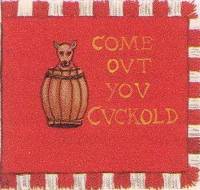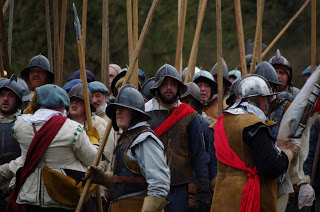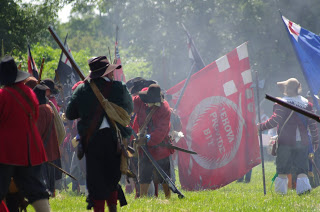Sir Horatio Cary's Regiment of Horse
You probably don't know much, or have even heard of Sir Horatio's Regiment of Horse but you will, no doubt, be aware of their cornets; nor may you know the story behind the less than subtle message emblazoned on the cornets.
Sir Horatio was originally a Parliamentarian, fighting as colonel of foot in Waller's Southern Association: Cary would defect to the Royalist cause shortly before the Siege of Bristol in 1643.

But what of the cornets I hear you ask? Two cornets are recorded, the Colonel's cornet having a red field, with an animal (which Richard Symonds described as "a fox being pulling (sic) the roundhead by the ears") emerging from a barrel with the motto "come out you cuckold"; the Major's cornet having a red field and "cuckolds we come". But why such provocative mottos?
The mottos are commonly believed (in a modern context) to make reference to the marital affairs of Robert Devereux, 3rd Earl of Essex. Or rather the affairs of his first wife, and possibly his second. Essex was married at age 13 to the 14 year old Frances Howard before being sent on a grand tour of Europe. The marriage was a political union, the newlyweds were separated after the wedding to prevent consummation and pregnancy at an early age. Essex returned to Britain two years later; during this time Frances had started a relationship with Viscount Rochester. Needless to say divorce proceedings were started by Frances, which were conducted in public, with claim and counter claim going back and forth. The divorce finally being granted in 1612.

Essex would later serve as juror in a case which saw his former wife and her lover stand trial for the murder of Sir Thomas Overbury (by poisoned enema, a method of murder sadly lacking from the game Cluedo), for which they were found guilty and sentenced to death (they would spend time in the Tower of London before being pardoned by James I). Essex would marry again, somewhat disastrously, and the gossip of the day claimed that Essex's son was actually fathered by Sir Thomas Uvedale.
Alternatively, and more likely given the wording of the major's cornet, the cornets could simply be slurring all roundheads rather than just Essex.
Not much is known about Horatio: one of four brothers, he was originally from Somerset, and one time Governor of Tetbury. He had an estate that straddled the border of County Durham and North Yorkshire which was sequestrated by Parliament after the First Civil War. Horatio fled the country in 1646, returning in 1649 when he submitted a case to the Compounding Committee as he wanted to buy back his estate, but could not provide the original deeds.
I had intended to 'do' lots of headswaps with this unit, it was only when I started gluing half painted riders to almost finished horses that I realised that I had completely forgotten. So, I present a straight out of the bag unit - with one minor exception, a wounded cavalry man in hat
| Cary's Cornet - original artwork by Tony Barton, from a Military Modelling series on ECW flags available to download via BCW Regimental Wiki |
Sir Horatio was originally a Parliamentarian, fighting as colonel of foot in Waller's Southern Association: Cary would defect to the Royalist cause shortly before the Siege of Bristol in 1643.
The history of the regiment is confused by Symonds's mistaken suggestion that the regiment was taken over by the Earl of Cleveland, and that Cary would raise a second regiment in the West Country. The details that we can attribute to Cary's are: possibly skirmishing at Westbourne, possibly at Cheriton, Storming of Leicester (where they numbered 200), Naseby, besieged at Bristol (the karmic circle catching up with Sir Horatio?), possibly at Sherburn in Elmet, before ended the War at the Siege of Oxford.

But what of the cornets I hear you ask? Two cornets are recorded, the Colonel's cornet having a red field, with an animal (which Richard Symonds described as "a fox being pulling (sic) the roundhead by the ears") emerging from a barrel with the motto "come out you cuckold"; the Major's cornet having a red field and "cuckolds we come". But why such provocative mottos?
The mottos are commonly believed (in a modern context) to make reference to the marital affairs of Robert Devereux, 3rd Earl of Essex. Or rather the affairs of his first wife, and possibly his second. Essex was married at age 13 to the 14 year old Frances Howard before being sent on a grand tour of Europe. The marriage was a political union, the newlyweds were separated after the wedding to prevent consummation and pregnancy at an early age. Essex returned to Britain two years later; during this time Frances had started a relationship with Viscount Rochester. Needless to say divorce proceedings were started by Frances, which were conducted in public, with claim and counter claim going back and forth. The divorce finally being granted in 1612.

Essex would later serve as juror in a case which saw his former wife and her lover stand trial for the murder of Sir Thomas Overbury (by poisoned enema, a method of murder sadly lacking from the game Cluedo), for which they were found guilty and sentenced to death (they would spend time in the Tower of London before being pardoned by James I). Essex would marry again, somewhat disastrously, and the gossip of the day claimed that Essex's son was actually fathered by Sir Thomas Uvedale.
Alternatively, and more likely given the wording of the major's cornet, the cornets could simply be slurring all roundheads rather than just Essex.
Not much is known about Horatio: one of four brothers, he was originally from Somerset, and one time Governor of Tetbury. He had an estate that straddled the border of County Durham and North Yorkshire which was sequestrated by Parliament after the First Civil War. Horatio fled the country in 1646, returning in 1649 when he submitted a case to the Compounding Committee as he wanted to buy back his estate, but could not provide the original deeds.
I had intended to 'do' lots of headswaps with this unit, it was only when I started gluing half painted riders to almost finished horses that I realised that I had completely forgotten. So, I present a straight out of the bag unit - with one minor exception, a wounded cavalry man in hat
If you enjoyed reading this, or any of the other posts, please consider supporting the blog.
Thanks.





.jfif)







Really interesting stuff, thanks for all the research
ReplyDeleteYou're welcome.
DeleteI've been pondering the question 'why a fox'?
Animals, flowers and objects all carry symbolism – we only have to think of Ophelia’s 'madness' scene in Hamlet where she distributes flowers to people (and the flowers she gives give us insight into the character traits of the recipients).
So what do foxes represent?
In Judeo-Christian tradition symbolism foxes are sly and cunning (a positive), yet Jesus calls Herod a fox – implying worthless and sly (clearly an insult).
Shakespeare’s foxes are sneaky and traitorous in Macbeth. In folklore foxes were associated with fraudulent behaviour, often symbolising the devil (or taxation!). In art and literature foxes represented deceitfulness.